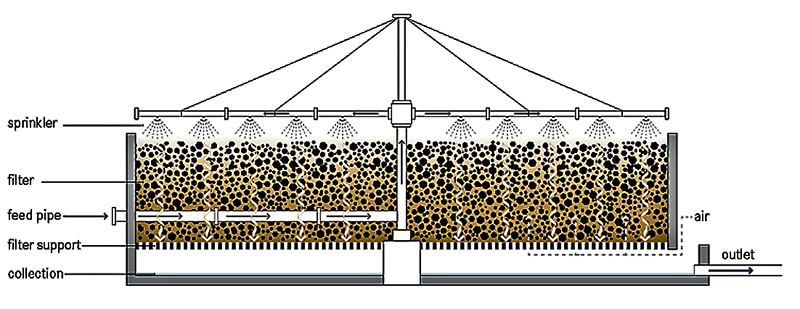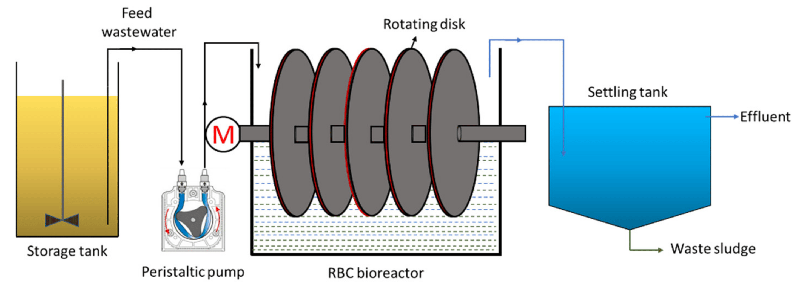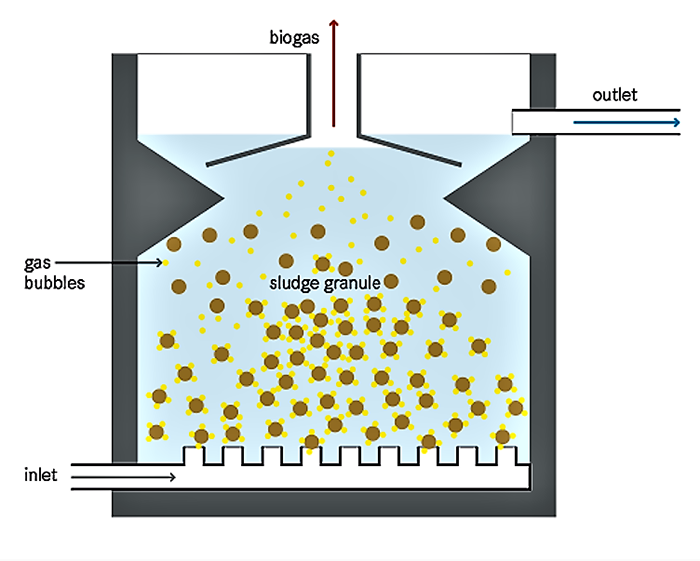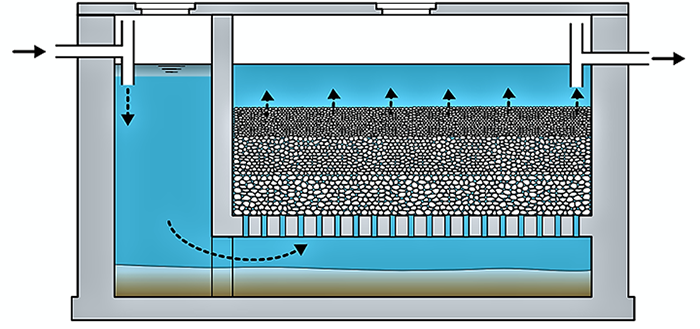Biological wastewater treatment is a critical process in wastewater treatment systems, leveraging natural biological activity to remove contaminants and purify water. This approach is essential for treating both municipal and industrial wastewater, ensuring the removal of organic matter, nutrients, and other pollutants before the water is released back into the environment or reused.
Biological wastewater treatment processes utilize microorganisms, such as bacteria, fungi, and protozoa to decompose organic pollutants present in wastewater. These microorganisms metabolize organic matter, converting it into carbon dioxide, water, and biomass. The process is divided into two main categories: aerobic and anaerobic treatment.

Aerobic biological wastewater treatment
Aerobic biological wastewater treatment is a key process in biological wastewater treatment that utilizes microorganisms requiring oxygen to decompose organic matter. This method is widely employed due to its effectiveness in treating a variety of wastewater types, including municipal sewage and industrial effluents. Types of aerobic treatment processes include:
Activated Sludge Process
The Activated Sludge Process is a highly effective and widely utilized method in biological wastewater treatment that relies on aerobic microorganisms to degrade organic pollutants. In this process, wastewater enters an aeration tank where it is mixed with a concentrated culture of microorganisms (activated sludge) and continuously aerated to supply oxygen, essential for microbial activity. These microorganisms metabolize the organic matter in the wastewater, converting it into carbon dioxide, water, and additional microbial biomass.
The mixture then flows into a secondary clarifier where the microbial flocs settle out, separating the treated water from the biomass. A portion of the settled sludge is recycled back to the aeration tank to maintain a stable microbial population, while the excess sludge is removed for further treatment or disposal. This process effectively reduces biochemical oxygen demand (BOD), suspended solids, and other contaminants, ensuring the treated effluent meets environmental discharge standards.

Trickling Filters
Trickling filters are a type of aerobic biological wastewater treatment process that utilizes a fixed bed of media, such as rocks, gravel, or plastic, to support a biofilm of microorganisms which degrade organic pollutants as the wastewater trickles over the surface. Wastewater is evenly distributed over the top of the filter and percolates downward through the media, where the biofilm absorbs and metabolizes the organic matter.
The process relies on natural ventilation or forced aeration to provide the necessary oxygen for microbial activity. As the wastewater passes through the media, the biofilm grows thicker and periodically sloughs off, carrying the biological solids with the treated effluent to a secondary clarifier for separation. Trickling filters are known for their simplicity, low maintenance requirements, and effectiveness in treating medium-strength wastewaters, although they can be susceptible to clogging and require a relatively large land area compared to other treatment methods.

Rotating Biological Contactors (RBCs)
Rotating Biological Contactors (RBCs) are an efficient and compact biological wastewater treatment method that involves a series of closely spaced, large-diameter discs mounted on a rotating shaft, partially submerged in wastewater. As the discs slowly rotate, they alternately expose the attached biofilm of microorganisms to the wastewater and the atmosphere, facilitating oxygen transfer and the degradation of organic pollutants. The rotation ensures that the biofilm remains well-oxygenated and continuously in contact with the contaminants in the wastewater, promoting efficient treatment.
The treated water flows out of the RBC unit to a secondary clarifier where the biological solids are settled out. RBCs offer advantages such as low energy requirements, high surface area for microbial growth, and consistent treatment performance, making them suitable for various wastewater applications, although they require regular maintenance to prevent biofilm overgrowth and mechanical issues.

Anaerobic biological wastewater treatment
Anaerobic biological wastewater treatment is a biological process used in wastewater treatment where microorganisms break down organic matter in the absence of oxygen. This process is particularly effective for treating high-strength industrial wastewater and sludge, as it produces biogas (primarily methane and carbon dioxide) that can be used as a renewable energy source. Types of anaerobic treatment processes include:
Anaerobic Digesters
Anaerobic digesters are specialized reactors used in biological wastewater treatment where microorganisms break down organic matter in the absence of oxygen, resulting in the production of biogas, primarily methane and carbon dioxide, and stabilized sludge. These sealed tanks provide a controlled environment that promotes the stages of anaerobic digestion: hydrolysis, where complex organic compounds are broken down into simpler molecules; acidogenesis, which converts these molecules into volatile fatty acids; acetogenesis, where acids are further converted into acetic acid, hydrogen, and carbon dioxide; and methanogenesis, where these products are finally transformed into methane and carbon dioxide.
Anaerobic digesters are particularly effective for treating high-strength industrial wastewater and sewage sludge, offering advantages such as energy recovery through biogas production, reduced sludge volumes, and lower operational costs compared to aerobic processes. However, they require careful management to maintain optimal conditions, such as temperature and pH, and are sensitive to toxic substances and sudden changes in wastewater composition.

Upflow Anaerobic Sludge Blanket (UASB) Reactors
Upflow Anaerobic Sludge Blanket (UASB) reactors are innovative anaerobic biological wastewater treatment systems used in wastewater treatment to efficiently degrade organic pollutants and produce biogas. In a UASB reactor, wastewater flows upwards through a dense blanket of granular sludge, creating ideal conditions for anaerobic microorganisms to thrive. As the wastewater passes through the sludge blanket, organic matter undergoes decomposition, producing methane and carbon dioxide gases that are collected at the top of the reactor.
The granular sludge acts as both a medium for microbial attachment and a filter for solids retention, ensuring effective treatment. UASB reactors are known for their high treatment efficiency, compact design, and minimal energy requirements compared to aerobic processes. They are particularly suitable for treating high-strength industrial wastewater and sewage with fluctuating flow rates, though they require careful monitoring of influent characteristics and hydraulic retention time to maintain optimal performance.

Anaerobic filters
Anaerobic filters are a type of biological wastewater treatment system used in biological wastewater treatment to degrade organic pollutants in the absence of oxygen. These filters consist of a container filled with a medium such as plastic or stone, which serves as a support for a biofilm of anaerobic microorganisms. As wastewater flows through the filter, organic matter in the water is broken down by the microbial community attached to the media.
The anaerobic conditions within the filter promote the conversion of organic compounds into simpler substances, including methane and carbon dioxide, which are released as biogas. Anaerobic filters are valued for their simplicity, reliability, and effectiveness in treating high-strength industrial wastewater. However, they require periodic maintenance to prevent clogging and ensure the stability of the biofilm, making them suitable for applications where consistent effluent quality and biogas production are priorities.

If you are considering implementing biological wastewater treatment solutions or need further information on how it can benefit your operations, feel free to contact us. Our experts are ready to discuss tailored wastewater management strategies that meet your environmental goals effectively

